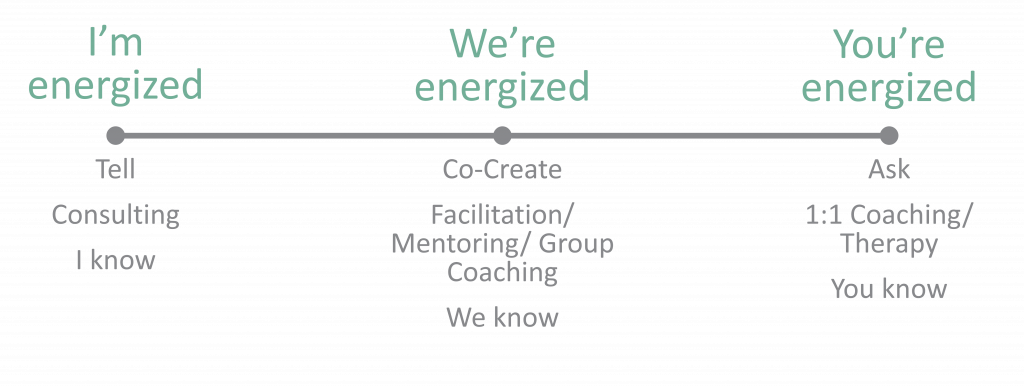I am taking a course on non-directive coaching. Beyond providing an opportunity to learn and practice a method, this experience is inviting me to interrogate what I believe about working with individuals and groups. So, in the spirit of “learning out loud” (a key skill when we’re collaborating in dispersed teams these days), and at the risk of caricaturing for the purposes of explanation, here’s what I’m noticing so far:
There’s a variety of approaches to gaining clarity with others. Let’s put them on a continuum from “I’ll tell you the answer” through “Let’s sort it out together” to “You tell me the answer.”

Roughly, these approaches correspond to the following roles and relationships:

My choice of approach stems, however, not just from our respective roles but more deeply from my beliefs about where the source of clarity lies. Fundamentally, do I believe that I know better? Is it best to pool our knowledge and figure out a solution together? Or does the answer lie within you, and my task is to help surface what you already know?

Within the non-directive coaching model lies a strong conviction that people are more likely to be empowered by, and therefore more sustainably implement, solutions they derived themselves. There is a stronger sense of ownership in generating an answer than to be handed one. So, if I am truly client focused, I will seek for you to be energized and motivated by our interaction rather than having the affirmation and endorphins flowing toward me. That comes from you finding your own answers.

I believe in the transformative power of an insightful, well-timed question. My 25 years of group facilitation give me a strong affinity for the idea that ownership and answers for solving a problem rest with the group, not with the facilitator. Yet as I apply these principles to a 1:1 coaching relationship, I’m noticing that my tendency is to pull us back toward group problem solving, even though our “group” is just the two of us. I come into the conversation with a belief that “two heads are better than one,” and it can cause me to insert myself too prominently into the co-creation of solutions.
This dynamic is accentuated when the client enters the conversation actively seeking advice. When they want to be “told,” is my response to “ask?” And in the spirit of client-centredness, is their reaction to my response one of gratitude or frustration? (Consider the mixed feelings when you ask a genuine question to which your conversation partner knows an answer, and their response is a variation of, “What do you think?” Sigh.)
Purists may say that this tension can be resolved by improving role clarity: “Do you want me to behave as a coach or as a consultant in this situation?” No doubt securing agreement on that is important, but I think what I’ve described points to something deeper. At our core, do we believe the solution lies with me/you or with us?
The alchemy of “us” remains powerful to me, so I’m trusting I can learn to be a coach who brings her full self to the conversation, not only with my questions and my silences, but also my viewpoints. The combination of my perspectives and yours can surely be leveraged in a way that adds to your agency and energy rather than robbing you of those. There’s lots to go around.

Thought-provoking and great article, Rebecca! Glad I stopped to read it!
I love the way you have painted this inherent challenge, both as a real life “reality” and a continuum of choice, that needs to be understood and consciously embraced by both parties. Made more challenging when time constraints and “just getting to the end” can force an approach, even when not desired. Ends justifying the means. Sage thinking, indeed!
I hope you and your family are well and continuing to thrive Rebecca.